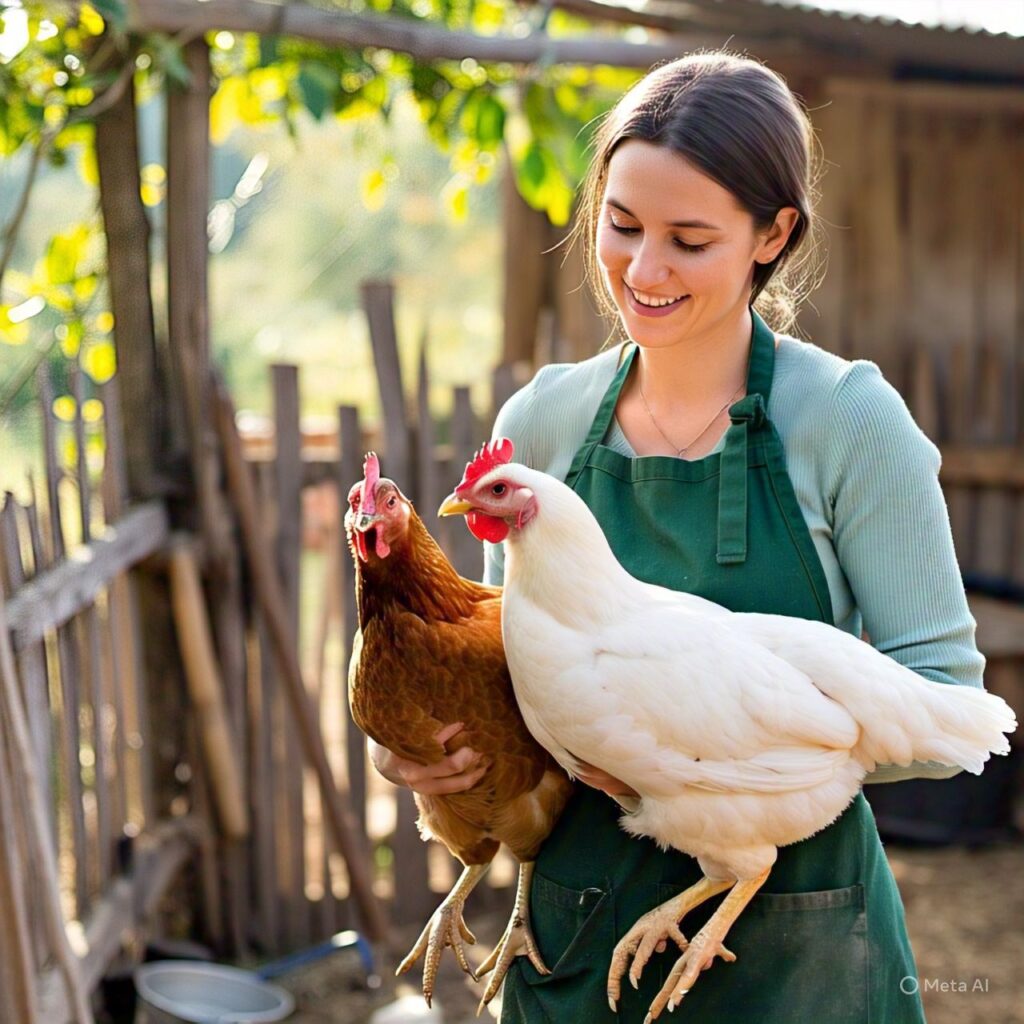Ordinary hens, the Gold Laced Wyandotte is here to shine! With golden feathers sketched in bold black, she looks like a royal ball covers her. And trust me, she knows it.
She never got crazy about beauty, but she also has a great business side. She’s a calm, friendly, and reliable layer, making her a perfect fit for any backyard flock. Most chicken keepers prefer this breed to add to their flock.
Perfect for all seasons, no extra care, and creates beautiful scenery. They check every box for beginners and seasoned keepers, also.
And yes, it’s still pronounced “why-en-dot.” Now you’re in the club 😉
Let’s meet this golden queen!
Here’s what we discuss in this article?
Why Is the Gold Laced Wyandotte So Popular?
What Is the Origin and History of Gold Laced Wyandotte?
How Big Is the Gold Laced Wyandotte Chicken?
Space Requirements for Gold Laced Wyandotte Chickens
Do Gold Laced Wyandotte Chickens Make Good Pets?
Are Gold Laced Wyandotte Chickens Good with Kids?
Are Gold Laced Wyandotte Roosters Aggressive?
Do Gold Laced Wyandotte Chickens Mix Well with Other Breeds?
How Many Eggs Does a Gold Laced Wyandotte Lay?
How Big Are Gold Laced Wyandotte Eggs?
When Will a Gold Laced Wyandotte Start to Lay?
What’s the Lifespan of a Gold Laced Wyandotte?
Are Gold Laced Wyandotte Chickens Cold Hardy?
Are Gold Laced Wyandotte Chickens Well Suited to Warmer Climates?
Are Gold Laced Wyandotte Chickens Prone to Illness?
Choosing Gold Laced Wyandottes: Are They Right For You?
Why Gold Laced Wyandottes Should Top Your Flock List
When Gold Laced Wyandottes Might Not Be Your Match
How Do Other Chicken Keepers Rate Gold Laced Wyandotte Chickens?
Why Is the Gold Laced Wyandotte So Popular?
In my favorite list, this breed is the first priority of mine over others like Barred Rock, Buff Orpington, and Silver Laced Wyandotte while choosing a breed for my backyard flock. This is popular due to their different characteristics, which are unique coloration of black and brown patterns, a dual nature, egg production, and meat.
What is the origin and history of Gold-laced Wyandotte?
They originally bred for utility as dual-purpose birds, but are remarkably pretty. First developed by Joseph McKeen in Wisconsin near Lake Winnebago, these ancestors came from crossing Dark Brahmas with Spangled Hamburgs.
Formally changed from “American Sebrights” to “Wyandotte” in 1883, they were named after a Native American tribe from upstate New York. Their laced heritage combines productive lives with few health complications.
How Big is The Gold Laced Wyandotte Chicken?
This variety of Wyandotte looks bigger due to its fluffy feathers. Hens grow to around 6 ½ lbs while roosters reach 8.5 pounds. Their rounded, sturdy bodies are supported by slim legs and elegant curves.
These mid-size birds weigh perfectly for backyard flocks – hens at 6.5 pounds and roosters being heavier at 8 pounds. From my experience raising them, they handle cold weather exceptionally well, their substantial size making them excellent chicken choices for northern climates.
Space Requirements for Gold Laced Wyandotte Chickens
Gold Laced Wyandotte chickens need generous coop space to thrive.
These big-bottomed gals require room to roam and exercise. Unlike some breeds, they are not great flyers, so flight risk is minimal, but they still tend to get cranky without regular access to graze outdoors. A decent-sized hanging feeder prevents overcrowding when these beauties eat.
Bantams offer another option if space is short. Bantam hens weighing around 24-26 ounces and roosters up to 30 ounces (like the Pekin bantam cross) deliver the same pazazz in smaller packages.
Do Gold Laced Wyandotte Chickens Make Good Pets?
As this breed has unique temperaments, they are calm and likely to make a society. Also, this is a dual-nature breed as they meet the production level of eggs and meat.
But they are not likely to become your lap chicks. They want a little bit of independence.
Overall, Yes! This is a good choice for your backyard.
Are Gold Laced Wyandotte Chickens Good with Kids?
They are a great choice for families with kids like silkies because they rarely pose a high risk of aggression toward children who learn to handle them properly.
My three-year-old occasionally gets told off by a mildly mardy hen with ruffled feathers, but there’s never any unwanted fuss – just enough character to keep things interesting without causing problems.
They’re consistently good, patient birds with minimal drama.
Are Gold Laced Wyandotte Roosters Aggressive?
Originally, this breed is not aggressive, but the rooster may be a little bit aggressive with humans.
Do Gold Laced Wyandotte Chickens Mix Well with Other Breeds?
These chickens can adjust to other types of chicken breeds.
They are likely to make a social society with Orpingtons like Buff and Lavender, Brahmas, Barred Rock, Speckled Sussex, Dominique, and other Wyandotte types like Blue, Silver, Columbian, and Partridge.
However, they might be slightly dominant, but with proper space and care, they will mix and live with other breeds.
How Many Eggs Does a Gold Laced Wyandotte Lay?
Normally, Gold laced Wyandotte lay an average of 200 to 250 eggs per year. We need to find the exact number of eggs per week.
We are doing surveys and asking chicken keepers about egg production. Many chicken keepers say that they lay 4 eggs per week; some of them say they lay 3 eggs if they have any health and capability issues. 1 or 2 of them say they lay 5 eggs per week.
How Big Are Gold Laced Wyandotte Eggs?
Primarily, this breed lays large eggs, which are 56 g in weight and a large type of egg compared to other breeds’ eggs.
When Will a Gold Laced Wyandotte Start to Lay?
Usually, this breed starts laying eggs within just 18 to 20 weeks of their age (4.5 to 5 months old). While it depends totally on these factors of chickens.
- Diet and Nutrition
- Daylight Hours
- Health and stress level
- Care and management
As they contain calm temperaments, they are not likely to sit. So, if you are planning to hatch chicks, then this breed will be a great choice for you.
What’s The Lifespan of a Gold Laced Wyandotte?
The age of this breed type lies between 5 and 12 years, while normally the average lifespan of this breed is 5-6 years. That’s a good time for laying chicken eggs and is beneficial for chicken keepers.
Are Gold Laced Wyandotte Chickens Cold Hardy?
Winter Warriors: Gold Laced Wyandotte Cold Hardiness
Yes, they are extremely cold-hardy. The breed’s rose-shaped comb makes them less open to frostbite during winter.
Their deep feathers are a benefit when temperatures drop below freezing. Unlike chickens with larger wattles, they can handle unheated coops even in the coldest regions of the United States.
I’ve watched mine standing in the snow looking perfectly comfortable while other breeds huddled inside.
These birds continue to lay eggs through winter when daylight hours are low. Their heavier body at 6-8 pounds helps retain heat, while the tight feathered bodies originally developed from Brahmas and Spangled Hamburg ancestors give them excellent insulation.
Having raised them through several Minnesota winters, I can recommend them for any cold climate.
Are Gold Laced Wyandotte Chickens Well Suited to Warmer Climates?
This breed can handle them in a warmer climate, but they are good in cooler temperatures due to their feathers. If you are from warmer areas and start keeping this breed, make sure to do all these things to prevent the warm air and temperature.
- Provide plenty of shade.
- Ensure constant cool and clean water.
- Manage good ventilation in the coop.
Are Gold Laced Wyandotte Chickens Prone to Illness?
Because of their thick feathers, they can be a bit more vulnerable to skin and feather parasites than breeds with lighter plumage, so it’s a good idea to learn how to spot and manage issues like lice and other pests.
Choosing Gold Laced Wyandottes: Are They Right For You?
Gold Laced Wyandottes can be placed in different chicken varieties, suitable for both beginners and people who are already keeping chickens. Unlike the super cuddly Silkie Chicken, they have a mild sassy streak, so they might not be your first choice if handling is your priority.
However, these heritage breed hens make a beautiful addition to any backyard flock.
Why Gold Laced Wyandottes Should Top Your Flock List
Beautiful Looks:
I’ve spent countless hours watching these gems strut around on sunny days. Their dazzling feather patterns aren’t just a perfect pic opportunity for social media posts—their regal image provides genuine joy. While looks aren’t everything, their visual impact is a genuine major plus point for this breed.
Reliable egg layers:
My experience shows their cold-hardy wardrobe truly delivers. These sturdy ladies lay large eggs consistently year-round.
When neighbors switch to the dreaded “S word” (supermarket) for winter eggs, my breakfast still comes fresh from the coop.
Contentedly cooped up:
Unlike flightier breeds that need freedom, Wyandottes genuinely don’t mind being confined. When the weather keeps them cooped up, they’re an egg-stremely good choice—happily spending time chatting with their fellow fowl rather than frantically pacing.
When Gold Laced Wyandottes Might Not Be Your Match?
If you’re looking for a softy who craves cuddles, think twice. While their fabulous feathers are fluffier than most, their friendliness runs cooler—your affection is often tolerated rather than enjoyed.
Their aloof persona creates a quirky personality that might make you chuckle, but the relationship happens on their terms. Nobody’s perfect, but these aren’t lap chickens.
Avoid adding a single chicken to an existing coop—they truly like being around their kind. Don’t deprive these poor gals by separating them from friends.
Also, reconsider if you live in a very warm climate, as these cold-hardy chicken varieties with stunning plumage don’t make for a great summer wardrobe.
How Do Other Chicken Keepers Rate Gold Laced Wyandotte Chickens?
In a recent survey, most of the chicken keepers are likely interested in keeping this breed again and again.


